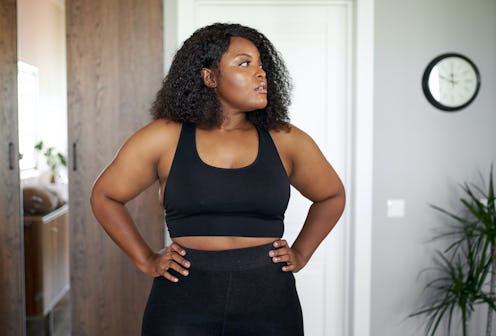Health
As suggested by experts.

Those living with endometriosis are fully aware of how much of an impact it can take on your everyday life. One of the common side effects of the condition is pelvic pain in your lower stomach or back, and experts are beginning to understand the role of the musculoskeletal system in endometriosis pain more and more. To help manage and handle this pain, the best stretches to try for Endometriosis often focus on improving your pelvic health through muscle balance, joint mobility, fitness and posture.
The University of Oxford has released a series of recommended stretches for those suffering with the condition in collaboration with Endometriosis Oxford Care and Nuffield Department Of Women’s & Reproductive Health. The exercises have been split into four categories: stretching, mobility, control, and strengthening, each focusing on a different area of improving pelvic health to help with pain.
Here are what each four of the categories can help with:
Stretching: “Commonly muscles can become tight and painful because of both posture, which may be in response to pain generated from endometriosis, and overuse, as other muscles become weakened requiring these muscles to compensate.”
Mobility: “Spinal mobility helps to optimise the function of muscles surrounding our pelvis and relieve symptoms of lower back pain.”
Control: “It is important to gain control in our core muscles for our muscles to be strong.” These core muscles include our pelvic floor and the transverse abdominis muscle.
Strengthening: “Muscles can become weakened in response to posture, pain and inactivity. Strengthening the pelvic muscles helps to rebalance control, reducing the body’s need to compensate using the muscles identified above.”
No matter which stretches you try, it is recommended that you start small and gradually build up your strength and resistance. Work within your body’s limits, don’t push, and take rest days in between stretch days.
I’ve selected a few stretches below and included the instructions on how to carry then out according to the experts at the University of Oxford, Endometriosis Oxford Care and Nuffield Department Of Women’s & Reproductive Health. A full list of the stretches (and accompanying pictures) can be found here.
Stretching
Hip Flexor Stretch In Standing
“Stand with one leg in front of the other. Raise your heel of the back leg and soften your knees. Tuck your bottom under so that your pelvis tilts under. You should feel a stretch at the front of your hip/ groin. Aim to hold for 30 seconds each side.”
Child’s Pose
“Bring yourself from seated kneeling into a forward position. You may feel a stretch into your back, shoulders and hips. You can also gently walk arms over to each side, holding for a short period of time to increase the stretch into your shoulders.”
Strengthening
Shoulder Bridge
“Lying on your back in your neutral position; engage your deep abdominal muscles. Squeeze your bottom muscles and start to raise your hips off the ground slowly and segmentally so that your tailbone is the first to lift. The movement should be as controlled as possible. Make sure that your ribs are always lower than your hips. As you come back down to the floor, you should ensure the movement is segmental and controlled so that your tailbone is the last part to touch the floor.”
Swimming Exercise
“Lying on your tummy in your neutral position (remember you need to tuck your bottom under); engage your deep abdominal muscles. Keeping length in your spine, lift one leg off the floor, feeling a squeeze in your bottom muscles. Alternate legs. Keep your arms relaxed and place a pillow under your tummy if required.”
Mobility
Cat & Cow Stretch
“On all fours with your knees and ankle hip width apart, curve back up towards the ceiling, tucking your bottom under and looking towards your tummy. Then arch back your spine down, looking forward and tilting your pelvis up to the ceiling. Aim to work fluidly between the two within comfort.”
Hip Twist
“Lying on your back with your knees together and bent. Slowly relax your knees down towards the floor, keeping your knees together and your shoulders on the ground. Repeat the other way.”
Control
Transverse Abdominis Activation
“Lie on your back or on your side or in sitting. Place your hands just slightly in from you hip bones so they are resting over your lower tummy. Completely relax your abdomen. Gently draw your lower abdomen away from your waistband (approx. 20% of your full squeeze). You should feel a gentle tension underneath your hands. You should see minimal movement of the abdomen and your upper abdominal muscles and back should remain still. Keep breathing and try to maintain the hold. If you feel it relax, don’t fight it, fully relax and start again. If you feel your upper abdominals, pelvic floor or other muscles kicking in, fully relax and reset. Start by completing for a few seconds and then build up the time, ensuring your body isn’t cheating.”
This article was originally published on